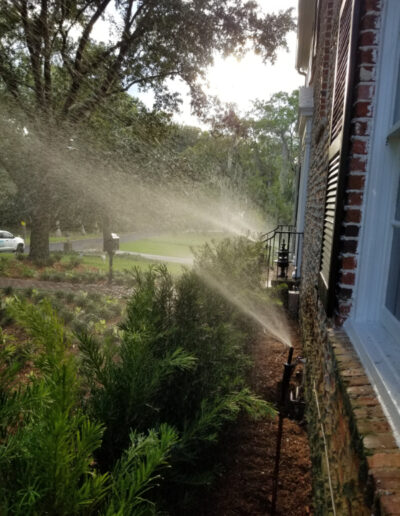When it comes to maintaining a lush, green lawn, an efficient irrigation system is indispensable. A well-planned lawn irrigation system can save water, time, and money while ensuring that your yard remains vibrant and healthy. In this comprehensive guide, we’ll delve into the essential aspects of lawn irrigation system installation, offering expert guidance to make the process as straightforward as possible.
Lawn Irrigation System Installation Made Easy with Expert Guidance
Installing a lawn irrigation system may sound daunting at first, but with the right guidance and planning, it can be a breeze. First off, it's crucial to understand what type of system best suits your landscape needs. You have options ranging from sprinkler systems to drip irrigation, each with its own unique benefits.
Understanding Different Types of Irrigation Systems
Sprinkler Systems: This is the most common type of irrigation for residential lawns. It disperses water through a network of pipes and sprinkler heads, covering a wide area efficiently.
Drip Irrigation: Ideal for gardens or landscapes requiring targeted watering, drip systems deliver water directly to the plant roots via tubes.
Soaker Hoses: These are flexible hoses that allow water to seep out slowly along their length; perfect for garden beds.
Smart Irrigation Systems: These utilize technology like weather sensors and timers to optimize watering schedules based on environmental conditions.
Choosing the Right System for Your Yard
Before diving into installation, assess your yard's size, shape, and water requirements. For example:
- If you have large open areas, a traditional sprinkler system may work best. For focused watering in gardens or flower beds, consider drip irrigation.
Planning Your Lawn Irrigation Installation
Once you’ve chosen your system type, it’s time to plan your installation. Here are some steps to help you get started:

1. Conduct a Site Assessment
Evaluate your yard’s layout:
- Identify areas that need more water. Take note of existing features like trees or patios that might affect water distribution.
2. Design Your Layout
Sketch out a plan:
- Mark where sprinkler heads or drip lines will go. Consider the reach of each sprinkler head—most cover around 10-15 feet in diameter.
3. Calculate Water Requirements
Understand how much water your grass and plants need:
- Typically, lawns require about 1 inch of water per week. Adjust based on rainfall and climate conditions in your area.
Selecting Professional Help for Installation
While DIY installations can save money upfront, hiring professional services can ensure efficiency and effectiveness in your setup:
- Look for reputable lawn sprinkler companies within your area. Check reviews for local contractors specializing in services like residential irrigation installation.
Essential Tools and Materials
If you’re opting for a DIY project, gather these materials:
| Item | Purpose | |-----------------------------|--------------------------------------| | PVC Pipes | Main supply lines | | Sprinkler Heads | Dispersing water | | Timer | Automating watering schedules | | Backflow Preventer | Preventing contamination |

Keep in mind that some tools may be specific to certain types of systems (like drip irrigation).
The Installation Process Step-by-Step
Now that you're well-prepared let's walk through the installation process:
Dig Trenches: Start by digging trenches where pipes will lay. The depth will depend on local frost lines but usually ranges from 6 to 12 inches deep.
Lay Down Pipes: Connect PVC piping according to your design layout—ensure you glue joints properly for leak prevention.
Install Sprinkler Heads: Place them at appropriate intervals based on coverage needs—test them before finalizing their positions.
Connect Rain Sensors (Optional): For smart systems, install rain sensors which automatically adjust watering based on rainfall.
Test the System: Run the system before covering any trenches with soil; check each section for leaks or performance issues.

Maintenance Tips for Your Lawn Irrigation System
Maintenance is key to prolonging the life and efficiency of your irrigation system:
- Regularly inspect all components for leaks or damage. Clear any clogged sprinklers or emitters. Adjust timers seasonally based on weather changes—this helps conserve water!
Frequently Asked Questions About Lawn Irrigation Installation
1. What are the benefits of using an automated lawn irrigation system?
Automated systems save time by independently managing watering schedules while ensuring optimal hydration levels based on weather conditions.
2. How often should I run my sprinkler system?
Typically once or twice a week is sufficient unless it's particularly dry outside; always adjust according to rainfall patterns.
3. Can I install a lawn irrigation system myself?
Yes! However, if you're unfamiliar with plumbing or electrical work required for certain systems (like smart timers), professional help might be beneficial.
4. What should I do if my sprinklers are unevenly distributing water?
Adjust their positioning or change nozzle sizes; sometimes replacing heads may also resolve coverage issues effectively.
5. How much does installing an automatic sprinkler cost?
Costs vary widely depending on yard size and complexity but generally range from $2,000 to $4,000 for full installations by professionals.
6. Are there eco-friendly options available?
Absolutely! Consider drip systems which use less water overall compared to traditional sprinklers; also look into rainwater harvesting solutions!
Conclusion: Making Lawn Irrigation System Installation Effortless
Armed with this guide on Lawn Irrigation System Installation Made Easy with Expert Guidance, you're now ready to tackle your project confidently! Whether you opt for professional help or decide on a irrigation installation DIY approach depends entirely upon your comfort level—but either way leads toward achieving that verdant paradise you've always desired!
With proper planning and execution—alongside regular maintenance—you'll enjoy not only lush greenery but also an eco-friendly approach towards conserving one of our planet's most precious resources: water! So get started today; bring life back into every blade of grass in your yard!